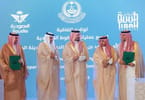Ahead of the one-year anniversary of the 8.0-magnitue earthquake, southwest China’s Sichuan province, once a tourist hotspot for both domestic and overseas tourists,has endeavored to rejuvenate its tourism industry shaken by last year’s May 12 earthquake.
As part of the measures, local authorities in Sichuan launched the unprecedented “price lowland” policy in late March offering considerable discounts to tourists from home and abroad for visiting scenic spots in the province.
“We set the goal of 2009 tourism income at 120 billion yuan (US$17.5 billion),” said Sichuan Tourism Bureau in an interview with chinadaily.com.cn.
The number hit 109.2 billion yuan (US$15.9 billion) last year, down 10.3 percent from 2007.
Most of the province’s tourism spots, including the world famous Jiuzhaigou, Mountain Emei and the Giant Buddha in Leshan City, will be open to visitors for free on May 12, the one-year anniversary of the earthquake. These tourist attractions will also be discounted by 50 percent during other days in May.
In the provincial capital of Chengdu, 15 million tourism cards, also known as “Panda Cards”, at a cost of only one yuan each, have been distributed to people outside Sichuan province, attracting tourists to visit up to 11 tourist attractions. The Panda Card was widely used during the recent May Day holiday.
Statistics form Sichuan provincial tourism authorities show that during the May Day holiday, the province received as many as 9.37 million tourists, a year-on-year increase of 14.4 percent, with the total income amounting to 2.88 billion yuan (US$422 million).
Among the visitors, about 50 percent used the Panda Card. “In my group, only 10 percent, or 3-4 tourists, had to buy tickets, while others all had the Panda Card,” said Xia Jiao, a tour guide with the Chengdu branch of China International Travel Service.
“Quake ruins tourism” has also become more and more popular in the province, which not only helps boost the tourism industry, but benefits local residents as well. During this year’s Spring Festival Holiday, quake ruins tourism brought 1.87 billion yuan (US$274 million) to Sichuan, accounting for 40 percent of the province’s total tourism income during the holiday. Donghekou Earthquake Relics Park, the first of its kind to commemorate last year’s May 12 earthquake, has welcomed more than 250,000 tourists since it opened last November.
Tourism has also offered many jobs to quake survivors who work as vendors, street cleaners, security guards and operate their own restaurants and inns.
Inbound Market – A Promising Income Source
The domestic market is not the only one being stimulated by the price lowland policy. The province has also attached great importance to the inbound tourism market, even amid the current global financial crisis.
European countries, China’s Hong Kong and Taiwan as well as Japan are the major focus of Sichuan’s inbound tourism market, according to the Sichuan Tourism Bureau.
“Most of the foreign tourists willing to visit post-quake Sichuan are from Europe and North America”, the bureau said, citing a report by Mckinsey & Company, a world leading management consulting firm.
European tourist arrivals in Sichuan province in 2008 was just 121,400, down 37.81 percent from 195,200 in 2007, due to the May 12 earthquake and global economic downturn.
Another report released by Sichuan tourism authorities on April 15 showed that foreign tourists are especially interested in Qiang ethnic group culture and the China Giant Panda Protection and Research Center in Wolong, both of which suffered serious destruction in the May 12 earthquake.
In March, a delegation from Sichuan province led by Vice Governor Huang Yanrong attended the Berlin International Tourism Exhibition, one of the world’s most famous exhibitions, aiming to promote five travel routes among European tourists.
The Sichuan delegation held a market program called “Night of Sichuan”, inviting more than sixty travel agencies and media, making it one of the most popular exhibition booths.
“It is estimated that nearly 200,000 people visited the Sichuan exhibition booth during the Berlin exhibition,” said Sichuan Tourism Bureau.
The promotion event brought new business opportunities to Sichuan. TUI,German’s No 1 tour operator, organized 20 travel agency representatives from more than 10 countries to visit Sichuan’s tourist sites in late March.
“We invited them to Sichuan so that they can have better understanding of the province and rebuild European tourists’ confidence in Sichuan,” the provincial tourism bureau told chinadaily.com.cn.
Hong Kong residents can apply for the Panda Card conveniently through four local travel agencies beginning on May 4. With the tourism card, each tourist can save as much as 708 yuan (US$104) on the admission fee.
Taiwan tourists who visited the pair of giant pandas “Tuantuan” and “Yuanyuan” at Taipei Zoo earlier this year can enjoy half price discounts and even get free tickets at many scenic spots in Sichuan.
Local tourism authorities will provide convenient online services for tourists, knowing that more than 50 percent of European tourists make travel plans and order tickets via the Internet.
Controversy on Tourism Reconstruction
Despite Sichuan’s ambition to revitalize tourism and the progress it has already made, several programs have sparked public debate about the proper use of reconstruction funds.
Beichuan, a county which suffered mass destruction in the earthquake, is reportedly building a quake museum at a cost of 2.3 billion yuan (US$336 million).The is compared to the county’s 2007 fiscal revenue of 114 million yuan (US$16.7 million).
Wu Chuangfu, an expert who led the expert panel planning the museum’s reconstruction, said that only 135 million yuan will go into the museum’s construction, while the remaining investments are being used to protect ruins, construct roads and strengthen the mountain areas, etc., according to an earlier China Daily report.
The museum is being regarded as a unique tourist destination featuring quake relics, with construction to be completed in four years. Museum visitors will be able to access the Tangjiashan Earthquake Lake by cable car. Other exhibits will include the ruins of Beichuan High School and the Beichuan county seat.
The Counter Strike (CS) playground, a simulated tactical games entertainment park built near the quake relics in the province’s Pengzhou City, is regarded by many people as disrespectful to those killed in the earthquake.
Inspired by the popular military-based video game CS, participants play tactical games with laser guns in an imagined realm of modern warfare.
Dai Jun, manager of the entertainment park, has made it clear that the area where the playground is located is an open field with a collapsed pavilion, blocked water channel and other barriers, and there are no deceased buried under the park.
A survey by sina.com showed that 54.3 percent of 22,793 people polled supported building such an entertainment park.
WHAT TO TAKE AWAY FROM THIS ARTICLE:
- In the provincial capital of Chengdu, 15 million tourism cards, also known as “Panda Cards”, at a cost of only one yuan each, have been distributed to people outside Sichuan province, attracting tourists to visit up to 11 tourist attractions.
- Most of the province’s tourism spots, including the world famous Jiuzhaigou, Mountain Emei and the Giant Buddha in Leshan City, will be open to visitors for free on May 12, the one-year anniversary of the earthquake.
- Another report released by Sichuan tourism authorities on April 15 showed that foreign tourists are especially interested in Qiang ethnic group culture and the China Giant Panda Protection and Research Center in Wolong, both of which suffered serious destruction in the May 12 earthquake.






















